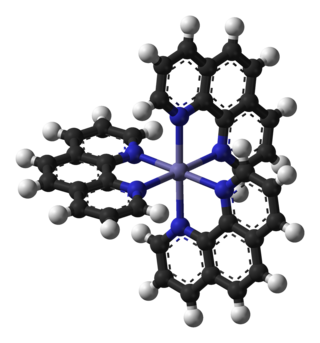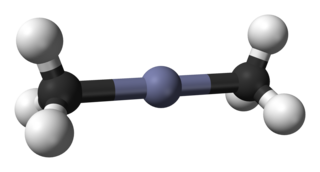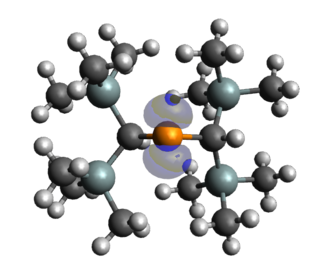Related Research Articles
In organic chemistry, a methyl group is an alkyl derived from methane, containing one carbon atom bonded to three hydrogen atoms, having chemical formula CH3. In formulas, the group is often abbreviated as Me. This hydrocarbon group occurs in many organic compounds. It is a very stable group in most molecules. While the methyl group is usually part of a larger molecule, bounded to the rest of the molecule by a single covalent bond, it can be found on its own in any of three forms: methanide anion, methylium cation or methyl radical. The anion has eight valence electrons, the radical seven and the cation six. All three forms are highly reactive and rarely observed.

Ethane is an organic chemical compound with chemical formula C
2H
6. At standard temperature and pressure, ethane is a colorless, odorless gas. Like many hydrocarbons, ethane is isolated on an industrial scale from natural gas and as a petrochemical by-product of petroleum refining. Its chief use is as feedstock for ethylene production.

Dimanganese decacarbonyl, which has the chemical formula Mn2(CO)10, is a binary bimetallic carbonyl complex centered around the first row transition metal manganese. The first reported synthesis of Mn2(CO)10 was in 1954 at Linde Air Products Company and was performed by Brimm, Lynch, and Sesny. Their hypothesis about, and synthesis of, dimanganese decacarbonyl was fundamentally guided by the previously known dirhenium decacarbonyl (Re2(CO)10), the heavy atom analogue of Mn2(CO)10. Since its first synthesis, Mn2(CO)10 has been use sparingly as a reagent in the synthesis of other chemical species, but has found the most use as a simple system on which to study fundamental chemical and physical phenomena, most notably, the metal-metal bond. Dimanganese decacarbonyl is also used as a classic example to reinforce fundamental topics in organometallic chemistry like d-electron count, the 18-electron rule, oxidation state, valency, and the isolobal analogy.

Hexafluoro-2-butyne (HFB) is a fluorocarbon with the chemical structure CF3C≡CCF3. HFB is a particularly electrophilic acetylene derivative, and hence a potent dienophile for Diels–Alder reactions.

Fullerene chemistry is a field of organic chemistry devoted to the chemical properties of fullerenes. Research in this field is driven by the need to functionalize fullerenes and tune their properties. For example, fullerene is notoriously insoluble and adding a suitable group can enhance solubility. By adding a polymerizable group, a fullerene polymer can be obtained. Functionalized fullerenes are divided into two classes: exohedral fullerenes with substituents outside the cage and endohedral fullerenes with trapped molecules inside the cage.

Ferroin is the chemical compound with the formula [Fe(o-phen)3]SO4, where o-phen is an abbreviation for 1,10-phenanthroline, a bidentate ligand. The term "ferroin" is used loosely and includes salts of other anions such as chloride.

Tetrathiafulvalene (TTF) is an organosulfur compound with the formula 2. Studies on this heterocyclic compound contributed to the development of molecular electronics. TTF is related to the hydrocarbon fulvalene, (C5H4)2, by replacement of four CH groups with sulfur atoms. Over 10,000 scientific publications discuss TTF and its derivatives.

Trimethylenemethane is a chemical compound with formula C
4H
6. It is a neutral free molecule with two unsatisfied valence bonds, and is therefore a highly reactive free radical. Formally, it can be viewed as an isobutylene molecule C
4H
8 with two hydrogen atoms removed from the terminal methyl groups.

Dimethylzinc, also known as zinc methyl, DMZ, or DMZn, is an organozinc compound with the chemical formula Zn(CH3)2. It belongs to the large series of similar compounds such as diethylzinc.
Unlike its lighter congeners, the halogen iodine forms a number of stable organic compounds, in which iodine exhibits higher formal oxidation states than -1 or coordination number exceeding 1. These are the hypervalent organoiodines, often called iodanes after the IUPAC rule used to name them.

Rhodocene is a chemical compound with the formula [Rh(C5H5)2]. Each molecule contains an atom of rhodium bound between two planar aromatic systems of five carbon atoms known as cyclopentadienyl rings in a sandwich arrangement. It is an organometallic compound as it has (haptic) covalent rhodium–carbon bonds. The [Rh(C5H5)2] radical is found above 150 °C (302 °F) or when trapped by cooling to liquid nitrogen temperatures (−196 °C [−321 °F]). At room temperature, pairs of these radicals join via their cyclopentadienyl rings to form a dimer, a yellow solid.

Decamethylferrocene or bis(pentamethylcyclopentadienyl)iron(II) is a chemical compound with formula Fe(C5(CH3)5)2 or C20H30Fe. It is a sandwich compound, whose molecule has an iron(II) cation Fe2+ attached by coordination bonds between two pentamethylcyclopentadienyl anions (Cp*−, (CH3)5C−5). It can also be viewed as a derivative of ferrocene, with a methyl group replacing each hydrogen atom of its cyclopentadienyl rings. The name and formula are often abbreviated to DmFc, Me10Fc or FeCp*2.

Difluorophosphate or difluorodioxophosphate or phosphorodifluoridate is an anion with formula PO2F−2. It has a single negative charge and resembles perchlorate and monofluorosulfonate in shape and compounds. These ions are isoelectronic, along with tetrafluoroaluminate, phosphate, orthosilicate, and sulfate. It forms a series of compounds. The ion is toxic to mammals as it causes blockage to iodine uptake in the thyroid. However it is degraded in the body over several hours.

In chemistry, dithiadiazoles are a family of heterocyclic compounds with the formula RCN2S2. Two isomers have been studied: the 1,2‑dithia-3,5‑diazoles, in which the sulfur atoms are bonded to each other across the ring from the carbon atom, and the 1,3‑dithia-2,5‑diazoles, in which nitrogen and sulfur atoms alternate around the ring. In both cases, the neutral species radicals that are of interest as examples of paramagnetic heterocycles. They have also attracted interest because of the tendency of the neutral species to form linear chain compounds, a theme in molecular electronics.
A phosphetane is a 4-membered organophosphorus heterocycle. The parent phosphetane molecule, which has the formula C3H7P, is one atom larger than phosphiranes, one smaller than phospholes, and is the heavy-atom analogue of azetidines. The first known phosphetane synthesis was reported in 1957 by Kosolapoff and Struck, but the method was both inefficient and hard to reproduce, with yields rarely exceeding 1%. A far more efficient method was reported in 1962 by McBride, whose method allowed for the first studies into the physical and chemical properties of phosphetanes. Phosphetanes are a well understood class of molecules that have found broad applications as chemical building blocks, reagents for organic/inorganic synthesis, and ligands in coordination chemistry.
In chemistry, the decay technique is a method to generate chemical species such as radicals, carbocations, and other potentially unstable covalent structures by radioactive decay of other compounds. For example, decay of a tritium-labeled molecule yields an ionized helium atom, which might then break off to leave a cationic molecular fragment.

A trivalent group 14 radical (also known as a trivalent tetrel radical) is a molecule that contains a group 14 element (E = C, Si, Ge, Sn, Pb) with three bonds and a free radical, having the general formula of R3E•. Such compounds can be categorized into three different types, depending on the structure (or equivalently the orbital in which the unpaired electron resides) and the energetic barrier to inversion. A molecule that remains rigidly in a pyramidal structure has an electron in a sp3 orbital is denoted as Type A. A structure that is pyramidal, but flexible, is denoted as Type B. And a planar structure with an electron that typically would reside in a pure p orbital is denoted as Type C. The structure of such molecules has been determined by probing the nature of the orbital that the unpaired electron resides in using spectroscopy, as well as directly with X-ray methods. Trivalent tetrel radicals tend to be synthesized from their tetravalent counterparts (i.e. R3EY where Y is a species that will dissociate).

Transition metal isocyanide complexes are coordination compounds containing isocyanide ligands. Because isocyanides are relatively basic, but also good pi-acceptors, a wide range of complexes are known. Some isocyanide complexes are used in medical imaging.

Organoberyllium chemistry involves the synthesis and properties of organometallic compounds featuring the group 2 alkaline earth metal beryllium (Be). The area remains understudied, relative to the chemistry of other main-group elements, because although metallic beryllium is relatively unreactive, its dust causes berylliosis and compounds are toxic. Organoberyllium compounds are typically prepared by transmetallation or alkylation of beryllium chloride.

Stable and persistent phosphorus radicals are phosphorus-centred radicals that are isolable and can exist for at least short periods of time. Radicals consisting of main group elements are often very reactive and undergo uncontrollable reactions, notably dimerization and polymerization. The common strategies for stabilising these phosphorus radicals usually include the delocalisation of the unpaired electron over a pi system or nearby electronegative atoms, and kinetic stabilisation with bulky ligands. Stable and persistent phosphorus radicals can be classified into three categories: neutral, cationic, and anionic radicals. Each of these classes involve various sub-classes, with neutral phosphorus radicals being the most extensively studied. Phosphorus exists as one isotope 31P (I = 1/2) with large hyperfine couplings relative to other spin active nuclei, making phosphorus radicals particularly attractive for spin-labelling experiments.
References
- ↑ MacLean, Gregory K.; Passmore, Jack; Rao, M. N. Sudheedra; Schriver, Melbourne J.; White, Peter S.; Bethell, Donald; Pilkington, Roger S.; Sutcliffe, Leslie H. (1985). "Preparation of 1,3,2-Dithiazolium Hexafluoroarsenate(V), Preparation and Crystal Structures of 5-Methyl-1,3,2,4-dithiadiazolium and 4-Methyl-1,3,2-dithiazolium Hexafluoroarsenate(V) and the Reduction of These Salts to Stable Free Radicals". Journal of the Chemical Society, Dalton Transactions (7): 1405. doi:10.1039/dt9850001405.
- ↑ Brownridge, Scott; Du, Hongbin; Fairhurst, Shirley A.; Haddon, Robert C.; Oberhammer, Heinz; Parsons, Simon; Passmore, Jack; Schriver, Melbourne J.; Sutcliffe, Leslie H.; Westwood, Nicholas P. C. (2000). "The Isolation, Characterisation, Gas Phase Electron Diffraction and Crystal Structure of the Thermally Stable Radical CF3CSNSCCF3". Journal of the Chemical Society, Dalton Transactions (19): 3365–3382. doi:10.1039/B001489N.
- ↑ Rees, Charles W. (May 1992). "Polysulfur-nitrogen heterocyclic chemistry". Journal of Heterocyclic Chemistry. 29 (3): 639–651. doi:10.1002/jhet.5570290306.